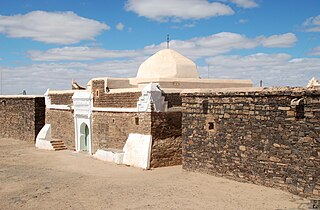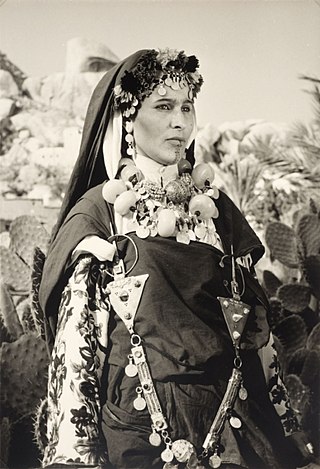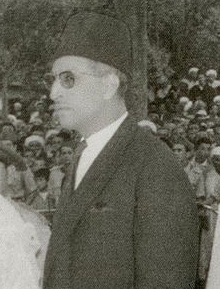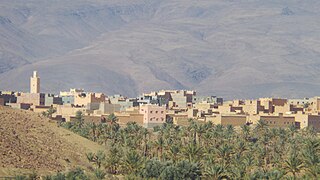Related Research Articles

Berbers or the Berber peoples, also called by their contemporary self-name Amazigh or Imazighen, are a diverse grouping of distinct ethnic groups indigenous to North Africa who predate the arrival of Arabs in the Arab migrations to the Maghreb. Their main connections are identified by their usage of Berber languages, most of them mutually unintelligible, which are part of the Afroasiatic language family. They are indigenous to the Maghreb region of North Africa, where they live in scattered communities across parts of Morocco, Algeria, Libya, and to a lesser extent Tunisia, Mauritania, northern Mali and northern Niger. Smaller Berber communities are also found in Burkina Faso and Egypt's Siwa Oasis.

MawlaySulayman bin Mohammed, born on 28 June 1766 in Tafilalt and died on 28 November 1822 in Marrakesh, was a Sultan of Morocco from 1792 to 1822, as a ruler of the 'Alawi dynasty. He was proclaimed sultan after the death of his half-brother al-Yazid. Sulayman continued his father's centralization and expansion of the kingdom, and most notably ended the piracy that had long operated from Morocco's coast. As part of Morocco's long running conflict with Spain and Portugal, Sulayman halted all trade with Europe. However, he continued his father's policies of close relations with the United States. He was also a follower of Wahhabism.

Mohamed Mustafa Ma al-'Aynayn was a Saharan Moorish religious and political leader who fought French and Spanish colonization in North Africa. He was the son of Mohammed Fadil Mamin, and the elder brother of shaykh Saad Bouh, a prominent marabout in Mauritania.

The Shilha people, or Schleuh or Ishelhien, are a Berber subgroup primarily inhabiting the Anti Atlas, High Atlas, Sous Valley, and Soussi coastal regions of Morocco.

Mbarek Bekkay was the 1st Prime Minister of Morocco between December 7, 1955, and April 15, 1958. Bekkay held the rank of colonel in the French army. He was the first Prime Ministers of Morocco since its independence from the French protectorate.

Central Atlas Tamazight or Atlasic is a Berber language of the Afroasiatic language family spoken by 2.3 million in the Atlas Mountains of Central Morocco as well as by smaller emigrant communities in France and elsewhere.

Zayanes are a Berber population inhabiting the Khenifra region, located in the central Middle Atlas mountains of Morocco.
Ait Attab is a large agricultural river valley on the northern edge of Azilal province in Morocco. Its population is divided into a multitude of hamlets called douwars in Darija, the largest one being Al Garage, which is also referred to as Ait Attab Center, or more simply as Ait Attab.

The French conquest of Morocco began with the French Republic occupying the city of Oujda in 29 March 1907. The French launched campaigns against the Sultanate of Morocco which culminated in the signing of the Treaty of Fes and establishment of the French Protectorate in Morocco on 30 March 1912. France later concluded, on the 27th November, the Treaty of Madrid with the Kingdom of Spain which established the Spanish protectorate in Morocco. The French still conducted a series of military operations to pacify rebellions in Morocco until 1934.

The Battle of El Herri was fought between France and the Berber Zaian Confederation on 13 November 1914. It took place at the small settlement of El Herri, near Khénifra in the French protectorate in Morocco. The battle was part of the Zaian War, in which the confederation of tribes sought to oppose continued French expansion into the interior of Morocco. Having captured the strategic town of Khénifra earlier in the year, the French, under General Hubert Lyautey, entered negotiations with Mouha ou Hammou Zayani, who led the Zaian. Lyautey thought that peace could be achieved and ordered Lieutenant-Colonel René Laverdure, who commanded the garrison in Khénifra, not to launch any offensives.

The pacification of Algeria was a series of military operations after the French conquest of the Regency of Algiers that aimed to put an end to various tribal rebellions, razzias and massacres of French settlers that were sporadically held in the Algerian countryside. The conflict was an early example of unconventional warfare.
Moha ou Said El Wirrawi was a Moroccan tribal leader who opposed French rule of the protectorate of Morocco. He formerly served as a caïd of the Moroccan sultans and fought for Sultan Abdelaziz against Bou Hmara in 1905. After the Treaty of Fes and the start of the French protectorate he opposed the French through military action. He participated in several battles with French forces in the Zaian War but was eventually forced into the High Atlas mountains where he died in action in 1924. His followers continued to resist the French over the next ten years.
Sidi Mhand n'Ifrutant was a Moroccan military leader active during the Zaian War.

Lucien Saint was a French administrator and politician.

Ait Touzine is one of the biggest Riffian tribes from the central Rif region in Morocco. The name Ait Touzine in its Berber original form is 'Ait Uzgn' meaning "The Children of the Half" perhaps implying a mixed ancestry.

Ahidus, also sometimes called ahidous,haidous, tahidoust or hidoussi, is a Berber style of collective performance in Morocco. It is the traditional dance in many Berber tribes and is known to be the favorite entertainment of these tribes.

N'Kob is a rural municipality in the Zagora province, in the Atlas Mountains. It is located near the Jbel Saghro and 24 kilometers from Tamsahelte. N'Kob is situated 35 kilometers west of the commune of Tazzarine and 40 kilometers from the intersection with the Draa Valley (Tansikht), the most spectacular stretch of the N9. The village has 45 Kasbahs and is surrounded by two oases full of palm trees, numerous of these ancient kasbahs have now been renovated and became hotels. The most widely spoken language in this region is Shilha (Tamazight). According to results of the 2014 general census of the population and households, the village has a population of about 7,209 people.

The Hafidiya was a coup d'état in Morocco between 1907 and 1908 in which Abd al-Hafid seized power from his brother Abdelaziz. Abd al-Hafid started his movement in Marrakesh in the aftermath of the Algeciras Conference, the French occupation of Oujda and of Casablanca and the gaining the support of Amazigh leaders in the south. The Ulama of Fes supported Abdelhafid only with an unprecedented Conditioned Bay'ah, or pledge of allegiance.
Anarchism in Morocco has its roots in the federalism practiced by Amazigh communities in pre-colonial Morocco. During the Spanish Civil War, Moroccan nationalists formed connections with Spanish anarchists in an attempt to ignite a war of national liberation against Spanish colonialism, but this effort was not successful. Despite the brief establishment of an anarchist movement in post-war Morocco, the movement was suppressed by the newly independent government, before finally reemerging in the 21st century.

Abdellah Zakour, also known as "Amghar Gou Ablla" was a Moroccan Berber military leader who opposed the French conquest of Morocco in the early 20th century.
References
- 1 2 3 4 Article about Assou Oubasslam Archived 2014-07-20 at the Wayback Machine
- 1 2 3 Article about Assou Oubasslam Archived 2016-09-17 at the Wayback Machine
- ↑ Hedna, Messaoud. "عسو أوبسلام.. أمازيغي هزم فرنسا في 'بوكافر' (Assou Oubasslam..An Amazigh who defeated France in 'Bougafer')". maghrebvoices.com (in Arabic). Retrieved 19 January 2024.
- ↑ Hedna, Messaoud. "عسو أوبسلام.. أمازيغي هزم فرنسا في 'بوكافر' (Assou Oubasslam..An Amazigh who defeated France in 'Bougafer')". maghrebvoices.com (in Arabic). Retrieved 19 January 2024.
- ↑ عسو أوبسلام القائد العسكري والسياسي المفاوض: صفحة خالدة من تاريخ المقاومة (Assou Oubasslam, the military and negotiating political leader: A timeless page from the history of resistance.) Archived 20 July 2014 at the Wayback Machine
- ↑ Hedna, Messaoud. "عسو أوبسلام.. أمازيغي هزم فرنسا في 'بوكافر' (Assou Oubasslam..An Amazigh who defeated France in 'Bougafer')". maghrebvoices.com (in Arabic). Retrieved 19 January 2024.